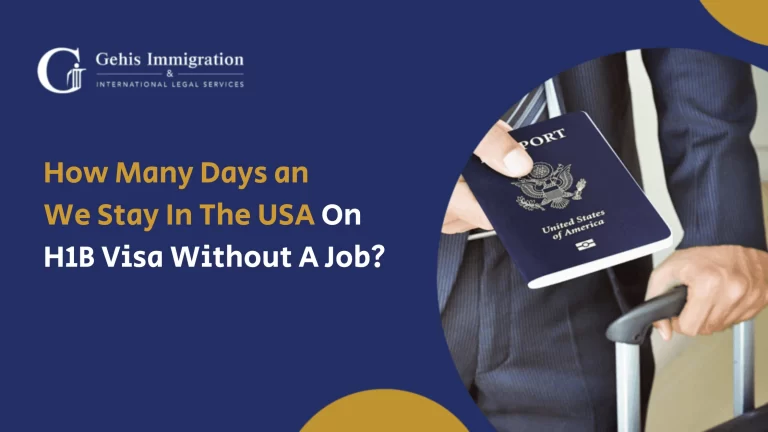The H-1B visa program is a linchpin of U.S. immigration policy, allowing American employers to recruit foreign talent for specialized positions. It has been instrumental in bridging skills gaps, fostering innovation, and driving economic growth. However, the evolving job market has led to a surge in demand for H-1B visa transfers.
The H-1B visa is a non-immigrant category allowing U.S. employers to hire foreign IT, engineering, healthcare, and finance professionals. It offers an initial three-year term, extendable to six years, affording foreign workers the chance to gain valuable U.S. experience and, in some cases, pursue permanent residency. This benefits employers seeking specialized skills and foreign workers with ambitions in the United States.
As H-1B visa holders advance their careers, they may seek fresh opportunities or face challenges necessitating employer changes. H-1B visa transfers facilitate this mobility, enabling foreign workers to explore new roles, negotiate improved terms, and align with evolving career goals. For U.S. employers, H-1B visa transfers offer access to a diverse talent pool, which is especially valuable when seeking specialized expertise or addressing sudden staffing needs.
This article is a current guide on transferring an H1b Visa To Another Employer. It covers eligibility criteria, step-by-step procedures, potential obstacles, and essential considerations. By providing insights and practical advice, this article empowers foreign professionals and employers to walk through the intricacies of H-1B visa transfers.
Eligibility and Requirements for Transfer an H1b Visa To Another Employer
- Current H-1B Status
To qualify for a Transfer of An H1B visa To Another Employer, the foreign worker must hold H-1B status in the U.S., indicating active employment with a U.S. employer under a valid H-1B visa.
- Valid H-1B Visa
The H-1B visa must be valid when the transfer petition is filed, ensuring it has stayed active and the I-94 departure record remains valid.
- Maintaining Status
The H-1B visa holder must have maintained lawful status during their U.S. stay, including compliance with their existing H-1B employment terms and conditions, such as working for the authorized employer in the specified role.
New Employer Eligibility
- Petitioning Employer Requirements
The new employer must meet specific criteria to file an H-1B visa transfer petition for the foreign worker, including:
- Being a U.S. employer willing to employ a foreign worker in a specialty occupation.
- Adhering to labor and immigration laws.
- Demonstrating the ability to pay the prevailing wage for the offered position.
- The job offered by the new employer should meet these standards:
- Qualifying as a “specialty occupation” demanding specialized knowledge and expertise.
- Aligning with the foreign worker’s qualifications and experience.
- Complying with prevailing wage rules, ensuring the worker receives at least the prevailing wage for the occupation in their specific geographic area.
- Meeting these eligibility requirements is vital for a successful H-1B visa transfer.
Non-compliance could result in the denial of the transfer petition. The foreign worker and the new employer must thoroughly understand and adhere to these conditions throughout the transfer process.
What Are The Key Steps in the H-1B Visa Transfer Process
- Finding a New Employer
- Job Search and Offer.
- Employer’s H-1B Sponsorship.
- Preparing the H-1B Transfer Petition.
- Required Documents.
- Submitting the H-1B Transfer Petition.
- USCIS Filing Process:
- Premium Processing Option.
- Distinguish between extension (with the same employer) and transfer (changing employers).
- Maintain Continuous Employment.
- Timing Considerations.
What is The Transfer of An H1b Visa To Another Employer Process For USCIS Processing and Approval
The USCIS processing and approval phase of an H-1B visa transfer involves several key elements.
There’s a waiting period as the U.S. Citizenship and Immigration Services (USCIS) reviews your application, with the duration varying. Processing times can vary based on factors like USCIS workload and the service center handling your case, so it’s essential to check USCIS processing time estimates.
Expedited processing, available for certain urgent situations, can shorten this waiting period for a fee. USCIS may issue a Request for Evidence (RFE) if they require more information or documentation, often related to issues like documentation, employment history gaps, or specialty job concerns.
Responding to an RFE promptly and comprehensively is crucial. Suppose your Transfer of an H1b Visa To Another Employer is approved. In that case, you’ll receive an Approval Notice specifying your transfer start date, allowing you to begin working for your new employer on or after that date. Staying informed and prepared throughout this process is key to successfully transferring an H1b visa to another employer.
How To Maintain Status After H-1B Visa Transfer
Maintaining your legal status following a Transfer of An H1b Visa To Another Employer is vital to ensure uninterrupted employment in the United States. Key considerations include promptly reporting significant changes to the U.S. Citizenship and Immigration Services (USCIS) to keep your records accurate and up to date, updating your address within 10 days of a change to avoid complications, and understanding that changing jobs may necessitate another H-1B transfer or a new visa application. When traveling abroad on an H-1B visa, ensure your visa stamp allows reentry and be prepared for a visa interview at a U.S. consulate if needed. Upon re-entry, carry essential documents, such as a valid passport, H-1B visa, and your Approval Notice from your new employer, for inspection by Customs and Border Protection officers at the port of entry.
What Are The Potential Challenges and Pitfalls In H-1B Visa Transfer Process
The Transfer of An H1B visa To Another Employer process can be complex, and several challenges and pitfalls may arise, including the potential denial of your H-1B transfer petition due to issues like eligibility, documentation, or employer compliance. Denial reasons may encompass insufficient documentation or concerns about the employer’s ability to pay the prevailing wage. In the event of a denial, you have various options, such as appealing the decision, reapplying with a different employer, or addressing the denial from abroad.
Additionally, you have dependents on H-4 visas. In that case, it’s crucial to consider their status during the transfer process, ensuring they maintain their H-4 status by adhering to visa terms and keeping USCIS updated. Understanding portability, grace periods, and the risks associated with employment gaps is also vital in maintaining your legal status throughout the process.






